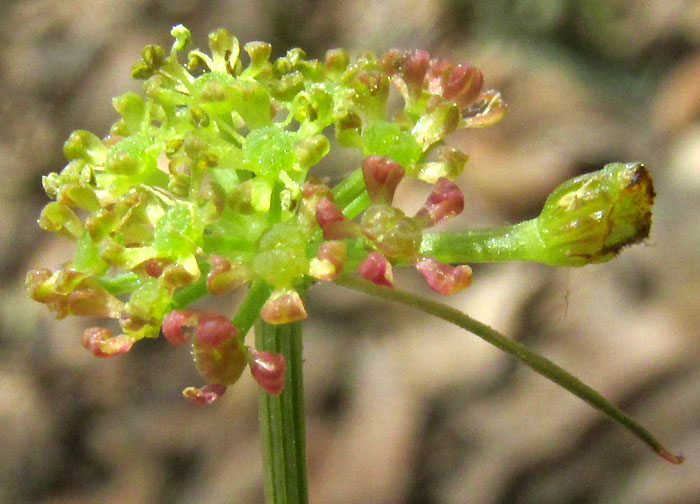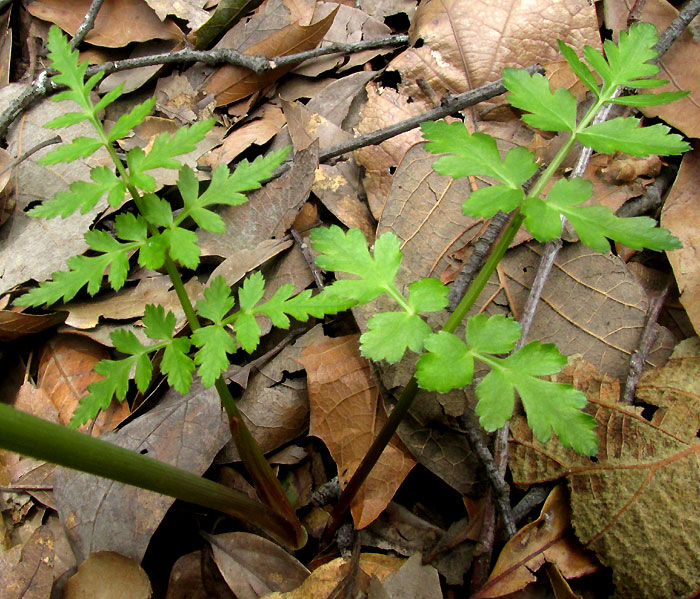Excerpts from Jim Conrad's
Naturalist Newsletter
entry from field notes dated June 29, 2022, taken in an oak forest on the slopes of Cerro de la Cruz, elevation ~2800m (~9200 ft), rising on the south side of the community of El Pinar, Amealco de Bonfil, Querétaro, MÉXICO, (~N20.17°, ~W100.17°)
ARRACACIA AEGOPODIOIDES

At the end of a very dry June, at this elevation in central Mexico, the forest feels very much like an oak forest in spring up north. This plant emerging from a thick carpet of oak leaves is suggestive of the similar looking and somewhat closely related Sweet Cicely, Snakeroot and other various "wild parsley" species. This group of plants, all with much-divided, ferny leaves, and tiny flowers clustered in umbel-type inflorescences, are members of the big Parsley Family, the Apiaceae or Ubelliferae, and our plant belongs to that family. But, that's a big family with about 3000 species worldwide, of which about 207 species in some 36 genera occur in Mexico. Which one is this?

The above flower arrangement is very typical of the Parsley Family. The tiny flowers are arranged in umbels, which are flower clusters in which flower stalks, or pedicels, of nearly equal length arise from a common center and form a flat or curved surface. Then each of the various umbels is connected to the main stem, or peduncle, so that the smaller umbels themselves are grouped into an umbel, referred to as a compound umbel.

This plant's compound umbel seen from below shows important identification features. Note that not all of the small umbels -- they can be called umbelets -- are on stems attaching to the same point atop the main stem. New stems bearing new clusters of umbelets arise from among the lowest umbelet-connecting point. At the picture's lower, left, what looks like two long, veiny bracts are actually the potential petioles of future leaves. As the plant grows and branches, the petioles will develop into leaves with long, blousy-bottomed petioles. At the picture's top, center one of the petiole tips shows teeth which later may become leaf lobes.

In the above umbelet the actual flower easiest to see is the one with 5 purplish petals a little right of center. Notice that the tip of each slender petal is curved upward and inward, a distinctive feature. On other flowers you may be able to see 5 stamens. These parts arise at the top of the green, hamburger-bun-shaped ovary, so the ovary is "inferior," as is the case with all members of the Parsley Family. The slender, green item pointing toward the picture's lower, right is a modified leaf, or "involucel bractlet," typical of the Parsley Family's umbelets.
Most flowers in the above head won't produce fruits. However, at the picture's far right, the knobby, green thing is a developing immature fruit partly eaten by somebody. Parsley Family flowers produce schizocarp-type fruits, meaning that the fruit is dry and splits into single-seeded parts when ripe. Despite the developing fruit's damage you can see that it's developing narrow vertical ridges with no spines, and that's a helpful fact.

The compound leaves are described as 2-3 ternate-pinnatifid, meaning that the blade is divided into three main parts, then each of those major subdivisions is subdivided, and sometimes each of those again is subdivided. Also, each final division is somewhat broad, not threadlike, as with many species in the family, such as fennel and yarrow. To identify this particular species it was helpful to notice that the base of the subdivision at the tip of the middle subdivision gradually diminishes downward forming narrow "wings" along the midrib, or rachilla, instead of ending abruptly with no wings.
These and other features lead us to the genus Arracacia, with up to 30 species occurring throughout the Americas, but not in North America. In Mexico we have 24 species, and this one is ARRACACIA AEGOPODIOIDES, described as occurring in oak, oak-pine and oak-juniper forests at elevations of 2000-2850 meters (6600-9400 ft). It's endemic just to upland central Mexico from about here in Querétaro south to Oaxaca.
Arracacia aegopodioides has no English name and in Spanish there's no commonly accepted one, though the 2003 book by Blanca Estela Pérez Escandón and others entitled Lista de las plantas útiles del Estado de Hidalgo reports that in Hidalgo state it's called Hierba del Venado, or "Deer Plant," which is a name shared by any number of other plants a deer might want to eat. The book also says that traditionally a tea has been brewed from it to treat the cough.
Otherwise, there's hardly any information about this species, though often it appears on lists, and pictures of it are posted on the Internet. Species in the genus are described as bearing tubers, and there's one species, Arracacia xanthorrhiza, native to the Andes and known as Arracacha, which produces such a large, good-tasting and nutritional tuber that in South America it's cultivated and grown commercially. It's to be remembered that carrot and parsnip plants are members of the Parsley Family.